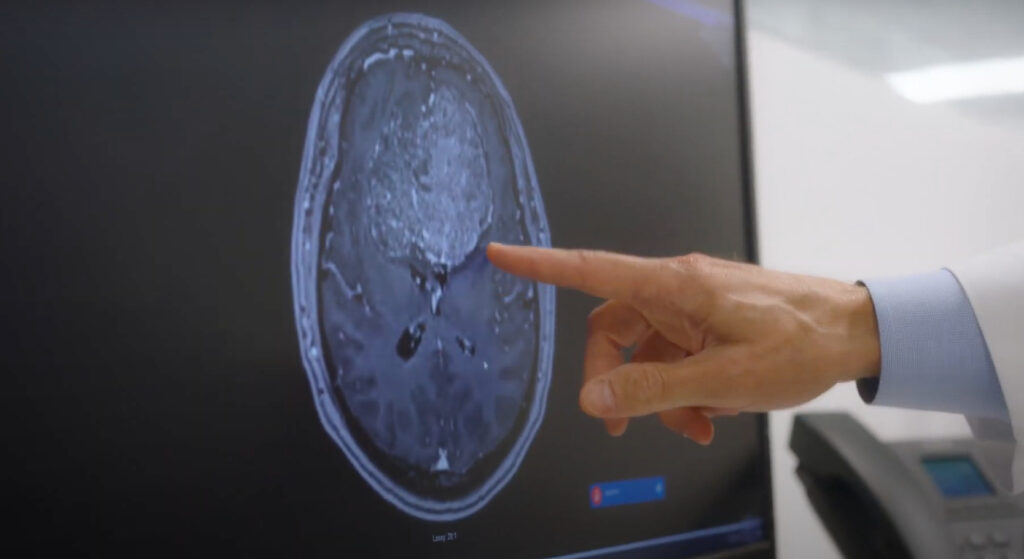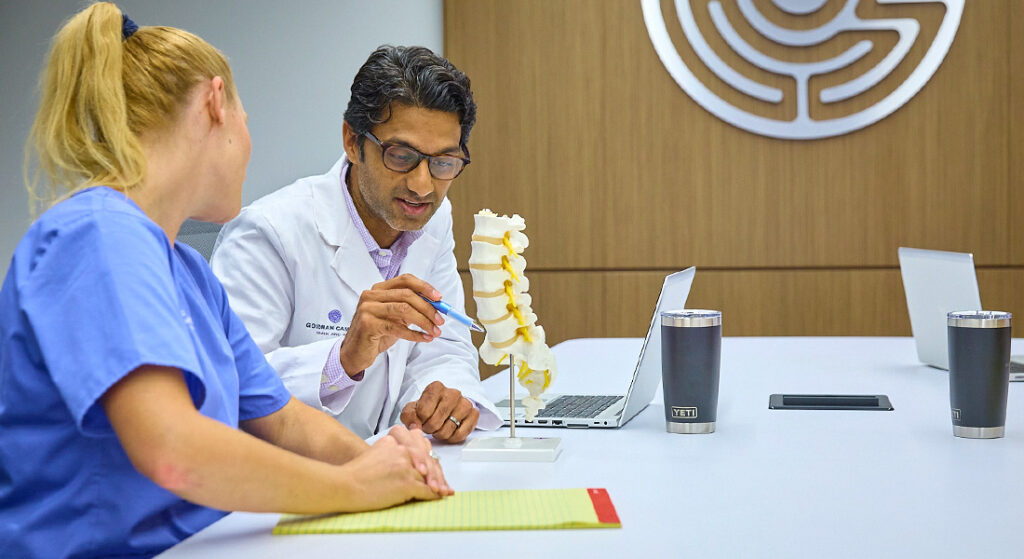
At Goodman Campbell, our focus is on research, innovation, and collaboration. But the main goal of our approach isn’t to stand out—to us, it’s more important to provide exceptional care for your patients that greatly enhances their quality of life.
So what about our approach is different? And why is that good for you and your patients?
Conferences for Collaboration
Every week, we host multidisciplinary conferences where our physicians, advanced practice providers, and other staff gather to share upcoming cases and their latest experiences. Patients with unique needs get their cases reviewed by multiple physicians working together toward a common solution. That means you don’t need to send your patients all over town for a second opinion—you can get multiple opinions right here within our walls.
With multiple subspecialties, our collaboration allows us to make sure your patient is seeing the right expert for their condition. When you send us a patient with a spine issue, they’ll be treated by a spine specialist. If your patient is a child with a tumor, a pediatric neurosurgeon will give them treatment. Many of our physicians have postresidency fellowship training, and we’re always happy to use that extra expertise on particularly difficult or complicated cases.
“When you see a doctor at our group, you’re getting a true expert: somebody who’s entirely devoted to that area of neurosurgery,” said Dr. Eric Potts, MD. “That’s compared to other places where a doctor might operate on a brain tumor, then do a lumbar fusion, and a carpal tunnel release after that. We think our approach leads to better patient care, especially over the long term.”
Having so many experts working together inevitably leads to great things. That’s why we’ll keep collaborating for the long haul. It’s just our culture.”
Quality Outcomes Backed by Data
How do we know we provide exceptional care? We meticulously track our patient outcomes. Goodman Campbell Brain and Spine has a long history of participation in Quality Registries. Tracking patient outcomes gives us the ability to analyze our clinical practice so we can see, in real time, what works and where we can adjust our approach to make care even better.
Our most robust registry is for spine care. When a patient is scheduled for surgery, they’re screened for enrollment in our spine registry. Following enrollment and prior to surgery, a Quality Team Member will call the patient and guide them through a survey designed to measure their pain, disability, and quality of life. After surgery, our team calls patients after 90-days, one year, and two years to track their surgical outcome.
“We follow our spine registry patients for two years after their surgery. It’s a touchpoint that other practices do not provide,” said Rachel Sickmeier, Quality Registry Manager. “When we look at our outcomes data, we are able to see that, over time, surgery decreases pain and disability across the board in our spine patients. And most important, our patients are reporting an increase in their overall quality of life, even two years after their surgery.”
Registry data can also be used for research. If a registry patient is pulled for a research project, the Quality Team will follow the patient for up to 10 years post-surgery to track their long-term outcomes.
“Many of our follow up patients love hearing from us,” said Sickmeier. “Our team’s ability to connect with a patient over the phone is really something special. They develop meaningful relationships over time, and we’ve found that many patients look forward to their follow up calls.”
We don’t just treat your patients; we build long-lasting relationships with them. These relationships uniquely situate our practice to catch potential problems early and ensure their quality of life well into the future.

It’s All About Research and Innovation
Being an independent practice gives us many advantages. One is the ability to freely dedicate our time and energy to learning more about innovative, life-saving procedures—as well as other new developments and research breakthroughs in our field. We conduct and contribute to this work regularly because we know there are always new things to learn and new, better options for patients.
Our physicians make it a point to have ongoing, consistent communication with patients. This carries over from clinical care to potential research opportunities. Physicians seek out research studies with an eye for those that will affect improvement in outcomes, both for current patients and those being treated in the future. “The physicians know their studies and are key in introducing them and the research team to patients,” said Heather Cero, director of academics and research. “When a patient takes part in a research study, the research nurse works closely with our clinical team. Offering another set of eyes on the patient’s care and one more important touchpoint. And because they have such a deep understanding of the latest research, they can address lots of different questions—and get patients connected.”
Research and innovation is just part of our DNA at Goodman Campbell. And it’s been that way since the beginning. “I think something that sets us apart is that our physicians have a strong desire to teach and continue to innovate,” said Cero. “It’s always been like that here. That provides a real advantage, because it gives our patients more options. There may be a new treatment that isn’t available outside of a research study, and we can often offer these if it’s an appropriate option.”
We’re all about giving our patients the best care and the most hope.
Let’s Work Together
If you have a patient in need of brain, spine, or nerve care, we’re here to help. Learn more about working with us, or give us a call at 317-396-1300 and let’s talk about how we can help get your patient the specialized, expert care they need.
